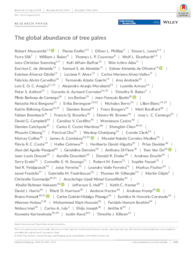The global abundance of tree palms.
The global abundance of tree palms.
Author(s): MUSCARELLA, R.; EMILIO, T.; PHILLIPS, O. L.; LEWIS, S. L.; SLIK, F.; BAKER, W. J.; COUVREUR, T. L. P.; EISERHARDT, W. L.; SVENNING, J.-C.; AFFUM-BAFFOE, K.; AIBA, S.-I.; ALMEIDA, E. C. de; ALMEIDA, S. S. de; OLIVEIRA, E. A. de; ÁLVAREZ-DÁVILA, E.; ALVES, L. F.; ALVEZ-VALLES, C. M.; CARVALHO, F. A.; GUARIN, F. A.; ANDRADE, A.; ARAGÃO, L. E. O. C.; MURAKAMI, A. A.; ARROYO, L.; ASHTON, P. S.; CORREDOR, G. A. A.; BAKER, T. R.; CAMARGO, P. B. de; BARLOW, J.; BASTIN, J.-B.; BENGONE, N. N.; BERENGUER, E.; BERRY, N.; BLANC, L.; BÖHNING-GAESE, K.; BONAL, D.; BONGERS, F.; BRADFORD, M.; BRAMBACH, F.; BREARLEY, F. Q.; BREWER, S. W.; CAMARGO, J. L. C.; CAMPBELL, D. G.; CASTILHO, C. V. de; CASTRO, W.; CATCHPOLE, D.; CERÓN MARTÍNEZ, C. E.; CHEN, S.; CHHANG, P.; CHO, P.; CHUTIPONG, W.; CLARK, C.; COLLINS, M.; COMISKEY, J. A.; MEDINA, M. N. C.; COSTA, F. R. C.; CULMSEE, H.; DAVID-HIGUITA, H.; DAVIDAR, P.; AGUILA-PASQUEL, J. del; DERROITE, G.; Di FIORE, A.; DO, T. V.; DOUCET, J.-L.; DOURDAIN, A.; DRAKE, D. R.; ENSSLIN, A.; ERWIN, T.; EWANGO, C. E. N.; EWERS, R. M.; FAUSET, S.; FELDPAUSCH, T. R.; FERREIRA, J. N.; FERREIRA, L. V.; FISCHER, M.; FRANKLIN, J.; FREDRIKSSON, G. M.; GILLESPIE, T. W.; GILPIN, M.; GONMADJE, C.; GUNATILLEKE, A. U. N.; HAKEEM, K. R.; HALL, J. S.; HAMER, K. C.; HARRIS, D. J.; HARRISON, R. D.; HECTOR, A.; HEMP, A.; HERAULT, B.; PIZANGO, C. G. H.; CORONADO, E. N. H.; HUBAU, W.; HUSSAIN, M. S.; IBRAHIM, F.-H.; IMAI, N.; JOLY, C. A.; JOSEPH, S.; K, A.; KARTAWINATA, K.; KASSI, J.; KILEEN, T. J.; KITAYAMA, K.; KLITGARD, B. B.; KOOYMAN, R.; LABRIÈRE, N.; LARNEY, E.; LAUMONIER, Y.; LAURANCE, S. G.; LAURANCE, W. F.; LAWES, M. J.; LEVESLEY, A.; LISINGO, J.; LOVEJOY, T.; LOVETT, J. C.; LU, X.; LYKKE, A. M.; MAGNUSSON, W. E.; MAHAYANI, N. P. D.; MALHI, Y.; MANSOR, A.; PEÑA, J. L. M.; MARIMON-JUNIOR, B. H.; MARSHALL, A. R.; MELGACO, K.; BAUTISTA, C. M.; MIHINDOU, V.; MILLET, J.; MILLIKEN, W.; MOHANDASS, D.; MONTEAGUDO MENDOZA, A. L.; MUGERWA, B.; NAGAMASU, H.; NAGY, L.; SEUATURIEN, N.; NASCIMENTO, M. T.; NEILL, D. A.; MENINI NETO, L.; NILUS, R.; NÚÑEZ VARGAS, M. P.; NURTJA, E.; ARAÚJO, R. N. O. de; ONRIZAL, O.; PALACIOS, W. A.; PALACIOS-RAMOS, S.; PARREN, M.; PAUDEL, E.; MORANDI, P. S.; PENNINGTON, R. T.; PICKAVANCE, G.; PIPOLY III, J. J.; PITMAN, N. C. A.; POEDJIRAHAJOE, E.; POORTER, L.; POULSEN, J. R.; PRASAD, P. R. C.; PRIETO, A.; PUYRAVAUD, J.-P.; QIE, L.; QUESADA, C. A.; RAMÍREZ-ANGULO, H.; RAZAFIMAHAIMODISON, J. C.; REITSMA, J. M.; REQUENA-ROJAS, E. J.; CORREA, Z. R.; RODRIGUEZ, C. R.; ROOPSIND, A.; ROVERO, F.; ROZAK, A.; RUDAS LLERAS, A.; RUTISHAUSER, E.; RUTTEN, G.; PUNCHI-MANAGE, R.; SALOMÃO, R. P.; SAM, H. V.; SARKER, S. K.; SATDICHANH, M.; SCHIETTI, J.; SCHMITT, C. B.; MARIMON, B. S.; SENBETA, F.; SHARMA, L. N.; SHEIL, D.; SIERRA, R.; SILVA-ESPEJO, J. E.; SILVEIRA, M.; SONKÉ, B.; STEININGER, M. K.; STEINMETZ, R.; STÉVART, T.; SUKUMAR, R.; SULTANA, A.; SUNDERLAND, T. C. H.; SURESH, H. S.; TANG, J.; TANNER, E.; STEEGE, H. ter; TERBORGH, J. W.; THEILADE, I.; TIMBERLAKE, J.; TOORES-LEZAMA, A.; UMUNAY, P.; URIARTE, M.; GAMARRA, L. V.; BULT, M. van de; HOUT, P. van der; VASQUEZ MARTINEZ, R.; VIEIRA, I. C. G.; VIEIRA, S. A.; VILANOVA, E.; CAYO, J. V.; WANG, O.; WEBB, C. O.; WEBB, E. L.; WHITE, L.; WHITFELD, T. J. S.; WICH, S.; WILLCOCK, S.; WISER, S. K.; YOUNG, K. R.; ZAKARIA, R.; ZANG, R.; ZARTMAN, C. E.; ZO-BI, I. C.; BALSLEV, H.
Summary: Aim: Palms are an iconic, diverse and often abundant component of tropical ecosys-tems that provide many ecosystem services. Being monocots, tree palms are evo-lutionarily, morphologically and physiologically distinct from other trees, and these differences have important consequences for ecosystem services (e.g., carbon se-questration and storage) and in terms of responses to climate change. We quanti-fied global patterns of tree palm relative abundance to help improve understanding of tropical forests and reduce uncertainty about these ecosystems under climate change.Location: Tropical and subtropical moist forests.Time period: Current.Major taxa studied: Palms (Arecaceae).Methods: We assembled a pantropical dataset of 2,548 forest plots (covering 1,191 ha) and quantified tree palm (i.e., ≥10 cm diameter at breast height) abundance relative to co-occurring non-palm trees. We compared the relative abundance of tree palms across biogeographical realms and tested for associations with palaeoclimate stability, current climate, edaphic conditions and metrics of forest structure.Results: On average, the relative abundance of tree palms was more than five times larger between Neotropical locations and other biogeographical realms. Tree palms were absent in most locations outside the Neotropics but present in >80% of Neotropical locations. The relative abundance of tree palms was more strongly asso-ciated with local conditions (e.g., higher mean annual precipitation, lower soil fertility, shallower water table and lower plot mean wood density) than metrics of long-term climate stability. Life-form diversity also influenced the patterns; palm assemblages outside the Neotropics comprise many non-tree (e.g., climbing) palms. Finally, we show that tree palms can influence estimates of above-ground biomass, but the mag-nitude and direction of the effect require additional work.Conclusions: Tree palms are not only quintessentially tropical, but they are also over-whelmingly Neotropical. Future work to understand the contributions of tree palms to biomass estimates and carbon cycling will be particularly crucial in Neotropical forests.
Publication year: 2020
Types of publication: Journal article
Unit: Embrapa Eastern Amazon
Observation
Some of Embrapa's publications are published as ePub files. To read them, use or download one of the following free software options to your computer or mobile device. Android: Google Play Books; IOS: iBooks; Windows and Linux: Calibre.
Access other publications
Access the Agricultural Research Database (BDPA) to consult Embrapa's full library collection and records.
Visit Embrapa Bookstore to purchase books and other publications sold by Embrapa.

